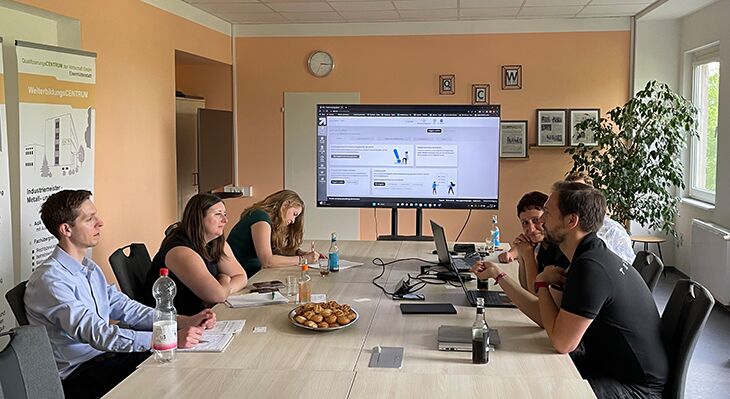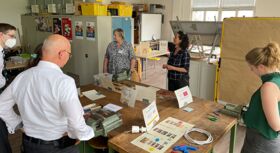Training in the USA – what happens between the ages of 18 and 29?
27.07.2023
At the request of the Executive Office of the President, GOVET arranged a study tour in Berlin and the surrounding area for a small delegation in mid-July. The main interest of the analysis team from the field of labor market and education was the political framework for securing a supply of qualified skilled workers.

Which tasks are assumed by the state federally and regionally in order to meet the requirements and challenges for the economy and the environment? There was one underlying question which acted as a guiding thread for the delegation from the US Office of Management and Budget (OMB) during its week-long visit to Germany. How can high school graduates in America successfully progress to a career pathway based on the apprenticeship model rather than waiting to complete a training programme with a minimum duration of two years at an average age of 29?
The model of practice-oriented initial and continuing vocational education and training has been debated at the highest political level in the USA for several years. In his 2015 State of The Union Address, Barak Obama stated: “Tonight, I’m also asking more businesses to follow the lead of companies like CVS and UPS, and offer more educational benefits and paid apprenticeships – opportunities that give workers the chance to earn higher-paying jobs even if they don’t have a higher education.”
Joe Biden issued a promise in his 2022 message delivered on the same occasion. “We’re also going to cut costs to keep the economy going strong and giving workers a fair shot; provide more training and apprenticeships; hire them based on skills, not just their degrees.”
George W. Bush und Donald Trump also committed themselves to the expansion of “apprenticeships” against the background of a massive shortage of skilled workers. The political will for more broadly based practice-oriented and company-based training thus exists.
Nevertheless, many US companies are hesitant about investing in human resources development, about nurturing cooperation between learning venues in a sustainable manner and about helping to draw up valid national standards. By way of contrast, German companies operating in the USA in the areas of engineering, plant construction and automobile manufacturing are seeking to provide more dual training and are receiving support in this regard from the chambers of commerce and industry abroad.
However, the administrative and organisational process is long, and training is expensive. Acquisition of trainees is also difficult. A further exacerbating factor is the low level of esteem in which teachers at community colleges are held. A career in this sector lacks attractiveness because of the poor payment on offer. Around 800,000 trainees in the USA currently enter an apprenticeship programme each year, and there is one thing which many young people leaving high school fail to realise. According to the Internet portal www.apprenticeship.gov, most trainees go on to earn around $80,000 annually. Approximately 90% remain with the companies where they were trained. The chances of securing permanent employment are thus excellent.
Insights into training structures and specialist networking

The delegates visited the three federal ministries in Germany relevant to vocational education and training. This enabled them to visualise the role played by the state in VET and the budgetary items contained in federal programmes. Core topics were broached via a technical introduction to the German VET system at the Ministry of Education and Research (BMBF) and by means of keynote presentations on current projects, projections and prognoses on the issue of ensuring the availability of a qualified workforce[1]. Themes such as the training guarantee, short-time working models and the Alliance for Initial and Further Training were showcased at the Federal Ministry of Labour and Social Affairs (BMAS). The Ministry for Economic Affairs and Climate Action (BMWK) focused on the Skills Experts Initiative at the chambers of commerce and industry abroad, on the national “Welcoming Guides” Programme aimed at integrating refugees into German companies and on aspects of international cooperation.
The delegation then moved from the meta level into VET practice. The first port of call was the Berlin-based training provider LIFE e. V., which for decades has been successfully conducting pilot projects and campaigns (Berlin Girls’ and Boys’ Day, EnterTechnik) on equal opportunities, anti-discrimination, transformative education and environmental and climate protection. The lively discussion which ensued mainly focused on the low-threshold approach adopted. STEM skilled worker training ranges high on the agenda of the education and labour market policy in the USA.
International consultancy on VET continuously demonstrates that the mechanism of cooperative training within the scope of pilot projects would be a particularly suitable option for small and medium-sized companies; even though the organisational process can be quite complex. The “Cooperative Training” Initiative at the Berlin Chamber of Commerce and Industry (IHK) and the Training Centre of the technology company ABB illustrated the pathway being pursued in the German capital. In some instances, public funding is provided to motivate more SMEs to offer initial and continuing VET. One delegation member said that U.S. companies would first have to learn to better understand that the costs only pay off in the course of the trainees remaining in the company after they have successfully passed their exams. The Head of the ABB Training Centre in Berlin told the delegation that he and his colleagues at ABB USA had been trying to introduce practice-oriented training. However, not successfully, apparently due to the complexity of the cooperation between learning venues and the organisation of the processes. The guests from the USA immediately took note of this.
The Bosch Company trains 6,000 young people in 30 occupations every year, including in the USA. In order to impart a picture to the delegation of the training provided by Bosch USA in the IT sector, key colleagues from America joined a live feed during a visit to the company’s Berlin base. The main thrust of the discussions was that corporate culture in the USA needs to develop in a way which allows trained skilled workers to remain with their companies and embark on a good career. The Head of Training at Bosch’s Stuttgart-Feuerbach, who had made the trip to Berlin, emphasised that one pathway to success was the targeted, individual fostering of talent within the company. He told the delegation about a new “Crazy Lab”, where trainees help develop prototypes for nearby start-ups.
The task and objective of the Charlottenburg-Wilmersdorf Youth Employment Agency is to offer young people the chance and prospect of training in the first place by creating a training capability. The agency ties together all social services for young people who are in specific or difficult situations, such as gambling or drug addiction or excess debt. The team acts in an action-oriented and pragmatic way to seek out individual solutions. It also lends close support to the young people in the application process. This compact and individualised provision met with considerable interest on the part of the delegation. During a brief visit to an upper secondary school centre specialising in motor vehicle engineering, the delegates and the director discussed the problem of the lack of teachers. Community Colleges in the USA are also short of thousands of teaching staff.
Transformation, the ecological shift and the skilled worker shortage are major issues in the USA too, especially at traditional industrial locations. The steel group ArcelorMittal invited the delegates to visit its Training Centre in Eastern German Eisenhüttenstadt, where they were joined by the Head of Training at the neighbouring TESLA Plant. The area of potential conflict rapidly became clear. Steel workers who will shortly be manufacturing green steel – at a company unknown to young people – are situated right next to a world-famous car builder which further processes the steel products. Both companies shared the view that poaching the young people from each other made little sense in a structurally weak and sparsely populated region. The whole group agreed that the way forward was to offer more high-quality training and to promote qualified work.
The participants wrapped things up by considering the joint findings of the German and American colleagues. Irrespective of the age at which training is commenced, vocational education and training offers a fair opportunity if the respective stakeholders work together, understand each other and have trust in the future qualified workforce.
German-US cooperation in vocational education and training
The BMBF maintains its cooperation with three American ministries (Commerce, Labour, Education) via a Joint Declaration of Intent (JDoI) in conjunction with the BMWK and the BMAS. Regular exchanges on ensuring the availability of a supply of skilled workers, labour market policy and vocational orientation has been taking place for years. GOVET provides technical support for the cooperation.
-
1
The purpose of the QuBe Data Portal is to illustrate the results of the BIBB/IAB qualifications and occupational field projections (QuBe Project), which are used to show possible development pathways for labour supply and demand.